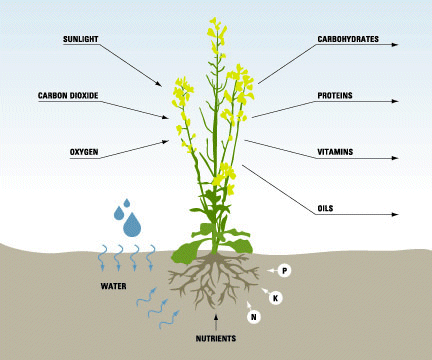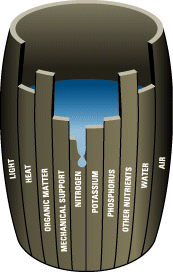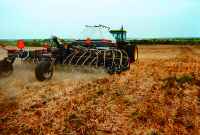| | Nutrient management planning | Reducing nitrogen and phosphorus losses | Manure application
Plants require nutrients in certain amounts, depending on the specific crop. The soil can provide some of these nutrients (Figure 3.7), but additional nutrients usually need to be applied. If insufficient nutrients are supplied, crop yields will drop. However, application of excess nutrients poses a threat to the environment. Matching nutrient levels to crop demand protects the environment and maximizes the benefit of supplying valuable nutrients to crops.

Figure 3.7. Green plants convert light, water, air and plant nutrients into forms useful to people and animals
Adapted from: Agriculture and Agri-Food Canada and Ontario Ministry of Agriculture and Food. 1994. Best Management Practices: Nutrient Management. Agriculture and Agri-Food Canada and Ontario Ministry of Agriculture and Food. p. 2.
The total amount of plant nutrients removed from the soil by a crop depends on the yield: the greater the yield, the greater the amount removed. Based on equal seed yields per unit area, whole barley, wheat and oat plants extract about the same combined quantities of nitrogen, phosphorus, potassium and sulphur from the soil, but considerably less than canola (Table 3.4). When only the seed is removed, and all straw is left on the field, barley removes slightly more nutrients from the soil than oats but less than wheat or canola.
Table 3.4. Nutrients used by crops (kilograms per hectare)*
| Crop | Crop Part | Nitrogen | Phoshporus (P2O5) | Potassium
(K2O) | Sulphur |
Wheat
(3225 kg/ha or 48 bu/ac) | Seed | 79 | 32 | 21 | 5 |
| Straw | 32 | 7 | 64 | 8 |
| Total | 111 | 39 | 85 | 13 |
Barley
(3225 kg/ha or 60 bu/ac) | Seed | 65 | 24 | 22 | 5 |
| Straw | 34 | 9 | 73 | 8 |
| Total | 99 | 33 | 95 | 13 |
Oats
(3225 kg/ha or 84 bu/ac) | Seed | 58 | 24 | 17 | 8 |
| Straw | 40 | 15 | 70 | 10 |
| Total | 98 | 39 | 87 | 18 |
Canola**
(3225 kg/ha or 57 bu/ac) | Seed | 120 | 57 | 29 | 21 |
| Straw | 70 | 26 | 121 | 17 |
| Total | 190 | 83 | 150 | 38 |
* To convert kg/ha to lb/ac, multiply by 0.89.
**Canola yield is extremely high, but to make the comparison, it was left at the same weight as the other grains.
Source: Western Canada Fertilizer Association, in Penney, D. 1998. Fertilizer Requirements of Cereals. Alberta Agriculture and Rural Development.
Organic fertilizer is fertilizer from organic sources, including manure, compost, decaying plant matter and sewage sludge. These fertilizers add organic matter to the soil and supply needed nutrients. Organic fertilizers release nutrients slowly over several years. These fertilizers may contain pathogens that can contaminate water sources. Overapplication of these fertilizers can increase the amount of salt in the soil. Organic fertilizers may not precisely meet the crop's nutrient requirements, and so you may need to supplement an organic fertilizer application with commercial fertilizers.
Commercial fertilizer, also called inorganic fertilizer, is manufactured from non-renewable resources. The nutrient content of these fertilizers is known and consistent, unlike organic fertilizers. Commercial fertilizer can be applied evenly and accurately, and nutrients can be applied at the rates required by the crop.
Crop residues are also a source of nutrients. Retaining crop residues on the field allows part of the nutrients taken up by the crop to be returned to soil. Nitrogen fixed from the air by legume crops, especially forage legumes, can add significantly to the supply of this nutrient in soil. Residues from cereals and grasses tend to be lower in nitrogen. Because soil microorganisms require nitrogen to break down these residues, the supply of nitrogen available to crops can be temporarily reduced when large quantities of crop residues are returned to the soil.
All agricultural operators must manage nutrients in accordance with the standards in the Agricultural Operation Practices Act (AOPA). Your first step is to ensure that your operation meets these standards (see Section 9.1.1); BMPs take your operation beyond these basic requirements.
Nutrient Management Planning
Nutrient management planning aims to optimize crop yield and quality, minimize fertilizer input costs, and protect soil and water. It focuses on applying the right amount of the right product in the right place at the right time. This involves setting realistic target yields, choosing the correctly balanced blend of nutrients, placing the nutrients as close to the growing plant as possible without damaging the plant, and applying the fertilizer as close as possible to the time the plants need the nutrients.
Nutrient management planning uses a balanced fertility perspective, considering the amounts of all nutrients in the soil and the crop's requirements (Figure 3.8). Basing fertilizer recommendations on only one nutrient results in unbalanced soil fertility. Calculating and applying the appropriate amount of each nutrient is called balanced fertility.

Figure 3.8. Plant growth is determined by most limiting growth factor
Adapted from: Agriculture and Agri-Food Canada. 2000. Nutrient Management Planning. Water Quality Matters Factsheet series.
Balanced fertility increases nutrient use efficiency, thereby reducing the risk of nutrient loss to the environment. A slight deficiency in one nutrient can affect the plant's ability to take up another nutrient. This results in unused nutrients that may be susceptible to leaching, runoff or gaseous losses. A well-fed crop produces a healthier, more extensive root system able to explore a greater area in search of nutrients and water. This results in more efficient extraction of nutrients and water, and because a higher yield is produced with the same amount of water, crop water use efficiency is improved.
Balanced fertility management also reduces erosion potential. The crop grows faster so the soil surface is covered more rapidly. In addition, more biomass is produced so more crop residues can be left behind to protect against erosion.
The eight steps to the nutrient management planning process are:
| 1. | Know the regulations that apply to your operation. |
| 2. | When using manure, test the manure for its nutrient content (nitrogen, phosphorus and potassium), and know the amount you will be applying. |
| 3. | Test the soil in your fields to determine nutrient levels, soil EC and soil pH. |
| 4. | Follow the soil test recommendations to meet your crop's nutrient requirements based on the soil test results, crop to be grown and expected yield. |
| 5. | When applying both manure and commercial fertilizer to a field, determine the rates of both to achieve balanced fertility. |
| 6. | If you are going to apply manure, prioritize your fields for manure application suitability (see box). |
| 7. | Calibrate your fertilizer application equipment. |
| 8. | When applying manure, take into consideration options to reduce odour nuisance for neighbours. |
Prioritizing fields for manure application - You may have one or more fields suitable for manure applications. It is important to consider several factors when comparing manure management options. For example, there may be some negative impacts to the environment on fields with higher nitrogen leaching or runoff potential.
The following check list provides some of the field characteristics that you should consider when selecting fields suitable for manure applications.
- Soil test N
- Soil test P
- Crop N requirement
- Leaching potential
- Erosion potential
- Runoff potential
- Slope
- Distance to water bodies
Rank each of the factors for the suitable fields with a relative ranking of low or high. Fields with a higher number of factors ranked low would get manure applied first.
- For more information, see Nutrient Management Planning (AAFC), Nutrient Management Planning for Livestock Production (ARD), and Alberta Fertilizer Guide (ARD).
Reducing Nitrogen and Phosphorus Losses
Losses of nitrogen and phosphorus from the soil through erosion, leaching or gaseous emissions can have serious environmental impacts (see Chapter 4) as well as economic impacts due to the loss of valuable crop nutrients.
BMPs to reduce losses of nitrogen and phosphorus include:
 | Develop and implement a nutrient management plan. |
 | Soil test annually to determine the soil's nutrient levels. |
 | Manage the four main aspects of nutrient application - application rate, application timing, application method and nutrient form |
 | 1. | The application rate is determined by taking into consideration soil test results, crop requirements and having realistic yield goals |
 |  |  Set yield goals based on such factors as anticipated growing conditions when determining crop nutrient requirements. If the yield potential turns out to be higher than expected, you may be able to apply additional nitrogen later. Set yield goals based on such factors as anticipated growing conditions when determining crop nutrient requirements. If the yield potential turns out to be higher than expected, you may be able to apply additional nitrogen later. |
 |  |  Based on the soil test recommendations, apply fertilizers to balance all nutrients to meet the crop's needs and anticipated moisture availability. Based on the soil test recommendations, apply fertilizers to balance all nutrients to meet the crop's needs and anticipated moisture availability. |
 |  |  If the soil test shows excessive nitrate levels, reduce the nitrogen application rate to draw down nitrate reserves in the soil. If soil phosphorus levels are excessive, reduce phosphorus applications so crop uptake will draw down the phosphorus levels, or grow crops such as alfalfa or grass hay that remove significant amounts of phosphorus. If the soil test shows excessive nitrate levels, reduce the nitrogen application rate to draw down nitrate reserves in the soil. If soil phosphorus levels are excessive, reduce phosphorus applications so crop uptake will draw down the phosphorus levels, or grow crops such as alfalfa or grass hay that remove significant amounts of phosphorus. |
 |  |  Avoid overapplication. Avoid overapplication. |
 | 2. | Application timing is crucial to maximize efficiency and reduce potential environmental hazards. |
 |  |  When possible, apply nitrogen in the spring just before or during seeding. Avoid applying large amounts in late summer, fall or winter. When possible, apply nitrogen in the spring just before or during seeding. Avoid applying large amounts in late summer, fall or winter. |
 | 3. | The application method can affect nutrient use efficiency and nutrient losses. |
 |  |  Incorporate solid manure or inject liquid manure. Incorporate solid manure or inject liquid manure. |
 |  |  Band nitrogen to the side of the seed row, rather than broadcasting. If placing nitrogen directly in the seed row, make sure you are using rates that will not damage the seed. Band nitrogen to the side of the seed row, rather than broadcasting. If placing nitrogen directly in the seed row, make sure you are using rates that will not damage the seed. |
 |  |  Band phosphorus with the seed or to the side of the seed row, because of its low mobility, for efficient crop utilization. Use caution when applying high rates of phosphorus directly with the seed because these rates may cause crop damage. Band phosphorus with the seed or to the side of the seed row, because of its low mobility, for efficient crop utilization. Use caution when applying high rates of phosphorus directly with the seed because these rates may cause crop damage. |
 | 4. | The nutrient form affects how much of the nutrient is available to the crop. Chemical and physical properties differ among commercial fertilizers. The availability of nutrients in organic nutrient sources, such as manure, is controlled by microbial processes. |
 | Check the fertilizer application equipment at least once per job to make sure it is working properly and is properly calibrated. |
 | Avoid applying nitrogen to wet areas. |
 | Take measures to prevent soil erosion (see Erosion Control). |
 | Decrease the amount of summerfallow land. |
 | Leave a buffer zone around lakes, streams and wells that meets or exceeds AOPA's setback requirements. Do not apply manure or commercial fertilizers to the buffer. |

Banding reduces losses of valuable nutrients.
Courtesy of RTL
- For more information, see Nutrient Management Planning for Livestock Production (ARD) and Nutrient Management Planning (AAFC). Consult a professional agronomist or crop specialist for advice on nutrient management.
Manure Application
Manure can provide organic matter and nutrients, but it must be properly managed. Overapplication can lead to problems such as contamination of water sources with nutrients and pathogens, emission of odours and greenhouse gases, nutrient loading in the soil leading to crop lodging and lower yields, and salt accumulation resulting in poor yields.
Testing soil and manure to determine their nutrient levels is the only way to be sure about how much manure to apply. Remember that some nutrients are released only gradually from manure and other organic fertilizers.
AOPA provides regulations for manure application and storage; BMPs take your operation beyond the basic requirements set by AOPA.
BMPs for manure applications:
 | Develop and implement a nutrient management plan. |
 | Determine manure application rate based on: |
 |  soil and manure tests, soil and manure tests, |
 |  the crop to be grown, and the crop to be grown, and |
 |  realistic yield goals. realistic yield goals. |
 | Use commercial fertilizers to supplement the nutrients supplied by manure. |
 | Incorporate solid manure as soon as possible, preferably within 12 hours, or inject liquid manure. Incorporation considerations should include measures to reduce soil erosion. |
 | Check the manure spreader at least once per job to make sure it is working properly and is properly calibrated. |
 | Apply manure uniformly. |
 | Rank fields by their suitability for manure application. |
 | Don't apply manure or other fertilizers on frozen ground. |
 | Apply manure in the spring if possible. |
 | Leave a buffer zone around lakes and streams, and do not apply manure or other fertilizers to the buffer. |
 | Ensure that the regulations for minimum setback distances from water bodies are met (see Section 9.1.1). If site-specific conditions (such as a high runoff potential) indicate that contamination may occur with the minimum setback distance, increase the distance. |
 | Compost manure and other organic fertilizers to reduce the amount of material that needs to be applied and to reduce transportation costs. |
 | Monitor potassium, calcium and magnesium ratios in forage grown on manured soils to prevent grass tetany and milk fever in livestock. Watch for high nitrate levels in annual cereal greenfeed or silage on heavily manured soils. Problem feeds should be diluted to safe levels. |
Back to Chapter 3 - Cropping Practices |
|